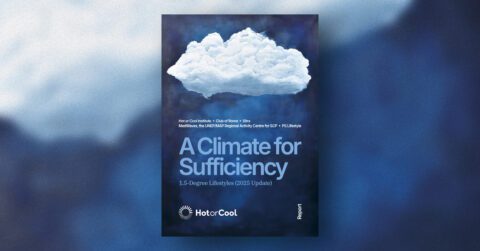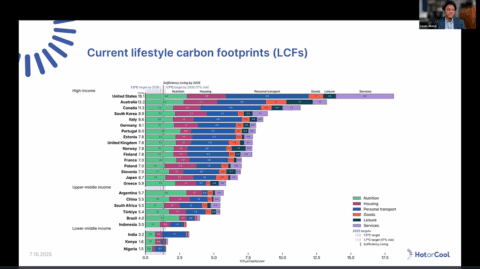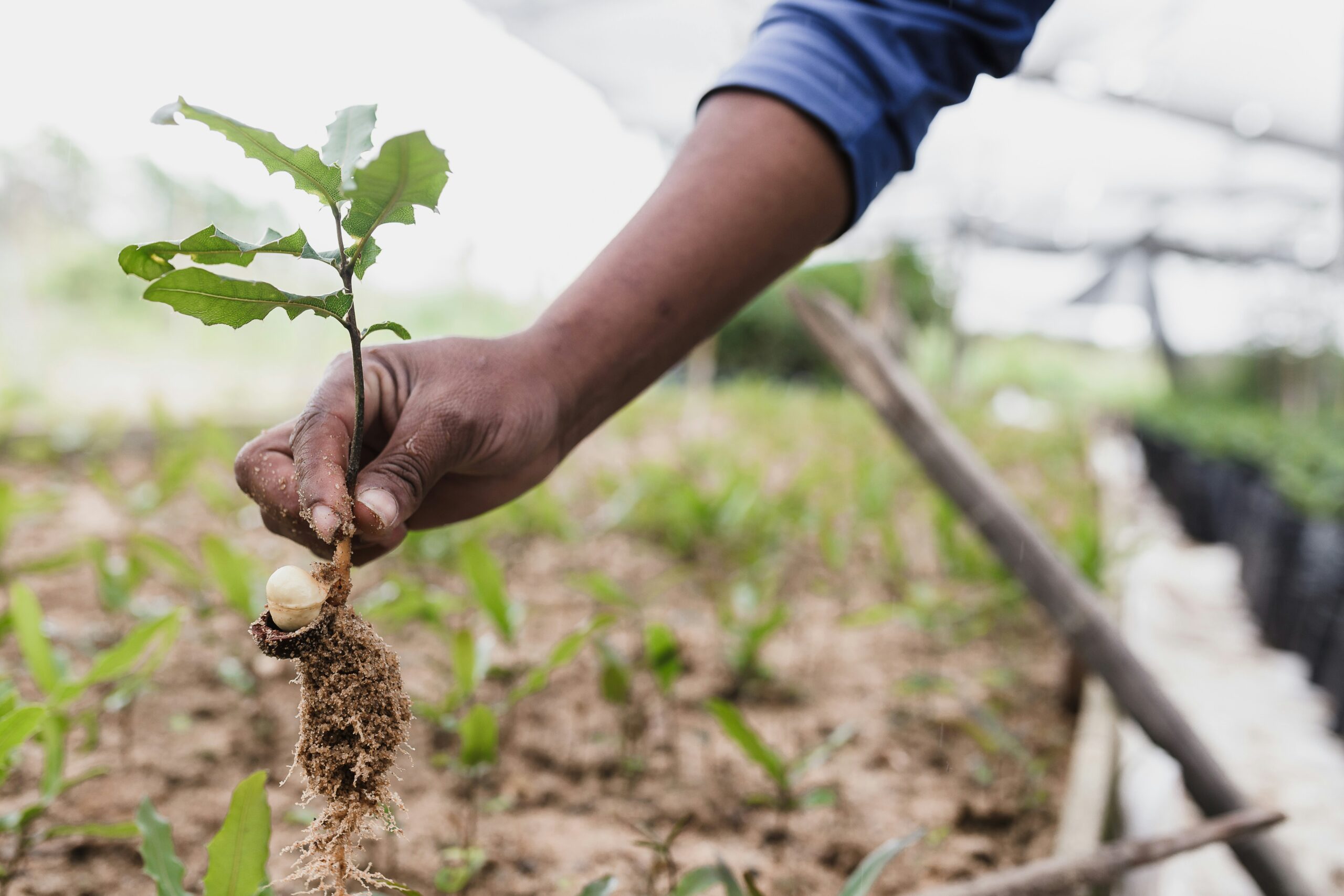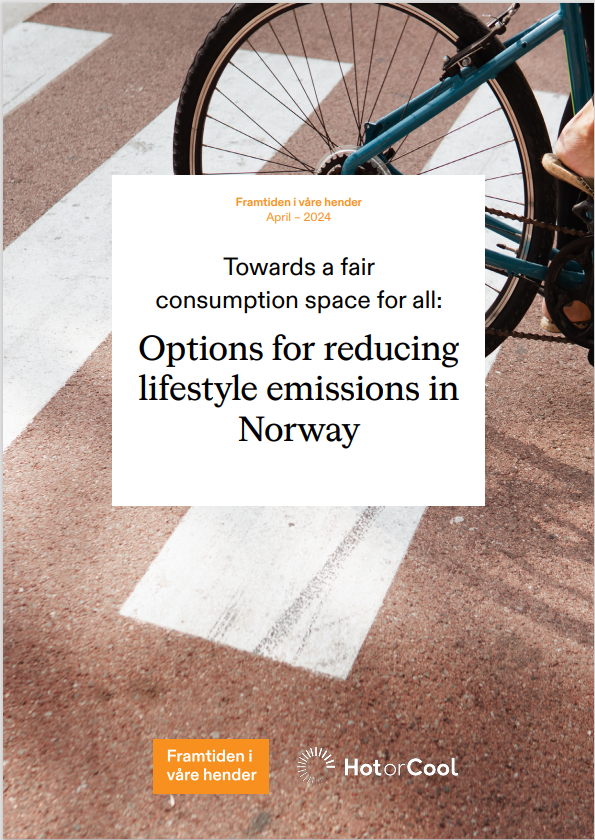
Inside the report
The world is rapidly approaching the 1.5°C guardrail, established to prevent catastrophic climate chaos. Drawing on data from 25 countries, it maps lifestyle carbon footprints, identifies emissions hotspots, and shows how the Fair Consumption Space framework can guide the development of fair pathways for living well in a stable and safe climate.
The report investigates which consumption areas cause the most emissions of climate-warming gases and compares current per-person emissions to the levels needed for meeting the internationally agreed warming limits of the Paris Agreement on Climate Change.
Central to the analysis is the concept of the Fair Consumption Space. It identifies a safe zone between maximum emissions for limiting global heating to 1.5°C (ecological ceiling), and the emissions associated with providing minimum material conditions for dignity, health, wellbeing and social participation (social floor). The report shows how equity is key to achieving inclusive human flourishing and climate safety.
Key insights
The report explores the fair consumption space for climate safety – the zone between an environmental ceiling and a social floor – and demonstrates how “sufficiency living”, defined by the material requirements needed for wellbeing without material excess, can support human flourishing, health and social participation while achieving climate safety.
– The ceiling represents the maximum lifestyle-related emissions compatible with limiting warming to 1.5°C.
– The floor represents the minimum material conditions required for dignity, health and social participation.
Both extremes are unsustainable: consumption above the ceiling drives ecological breakdown, while levels below the floor deny people a decent life. Crucially, these are inter-linked: the more some groups in society consume beyond a fair share, the harder it becomes to lift others to the floor level while keeping within a shrinking global carbon budget.
Providing sufficiency living with technologies in common use today would generate emissions of about 3.9 tCO₂e per person per year, well below today’s average levels in most countries but far above the 1.1 tCO₂e per person that is required by 2035 to keep heating below 1.5°C.
Projections by the UN indicate that we are headed towards a warming of 2.6-3.1°C by the end of this century. The scenario presented in this report shows that this is an avoidable future. A worldwide shift to sufficiency living combined with accelerated deployment of low-carbon technologies and practices could bring per-capita emissions down to 1.3 tCO₂e by 2035. This emission level is consistent with a pathway well below 2°C, though still above what’s needed for 1.5°C.
This report argues that we can still bend the curve back towards 1.5°C, but this will require more than rapid technological deployment. It demands deep reforms in provisioning systems, alongside shifts in cultural and social values that place equity and ecological responsibility at the center of development. It also calls for mainstreaming sufficiency within climate, economic, and social agendas, and for bringing in new actors that have not yet been part of the conversation.
The average lifestyle carbon footprint across the 25 countries analysed in the report is 7.1 tCO₂e per person per year – more than six times the 1.5°C-aligned target of 1.1 tCO2e for 2035. The analysis reveals vast inequalities. The highest average lifestyle footprint is in the United States at 18 tCO₂e per person per year, which is more than 10 times that of Nigeria at 1.5 tCO₂e per person per year.
To align with the 1.5°C target by 2035, average lifestyle emissions must fall by:
- 82% to 94% in high income countries,
- 64% to 81% in upper-middle income countries, and
- 29% to 67% in lower-middle income countries.
Lifestyle changes that directly address overconsumption can reduce per-capita footprints considerably. The greatest impacts are found in:
Nutrition: adopting plant-based, vegetarian, or planetary-health diets can cut 1,000–2,500 kgCO₂e per person annually, depending on country.
Transport: avoiding private car use in urban areas, shifting to public and active transport, and reshaping urban planning so people live closer to work or study can each save over 1,000 kgCO₂e per person per year, especially in car-dependent countries.
Housing: retrofitting buildings, applying passive standards, using low-carbon materials, and switching to clean heating and cooling systems reduce energy demand and emissions at scale.By focusing on these hotspots, sufficiency becomes both a guiding principle and a practical pathway for aligning lifestyles with climate targets.
These domains are universal priorities for reducing emissions, but the most impactful actions differ across countries – underscoring the need for tailored, context-specific pathways to low-carbon futures.
Overall, the findings of this report make clear that incremental efficiency improvements are insufficient. Fundamental societal transformations are needed to enable climate-compatible, socially just lifestyles. The recommendations include six critical actions at the collective and individual levels, to avoid crossing socio-ecological red lines.
- Bend back the emissions curve: recommit to 1.5°C – Governments must urgently recommit to 1.5°C, and adopt concrete, verifiable, and time-bound plans, preferably legally binding, with compulsory reductions for business and strong international co-ordination. “Too late” narratives only serve the status quo. The curve can still be bent back – if rapid, co-ordinated action is taken.
- Implement globally co-ordinated taxes and wealth caps – Globally co-ordinated fiscal tools can curb harmful excess and redistribute opportunities fairly. These include progressive income, wealth and inheritance taxes; comprehensive capital gains taxation; maximum income–minimum income ratios; and absolute wealth ceilings. Revenues should be redirected to fund universal basic services and sufficiency-oriented infrastructure. Such policies are not unprecedented. In the 1940s, the top marginal tax rate in the United States reached 94%, greatly reducing inequality. Today, globally co-ordinated action on wealth and taxation could both fund sufficiency for all and reduce social tensions that undermine climate co-operation.
- Change aspirations and catalyse large-scale social innovation– Shifting towards sufficiency means redefining social aspirations beyond consumerism and overconsumption, and building collective visions rooted in care, wellbeing, and shared prosperity within planetary limits. By leveraging social tipping dynamics—such as removing fossil fuel subsidies, strengthening climate education, restricting excessive wealth accumulation, and phasing out harmful consumption options like private jets—societies can trigger rapid systemic change while expanding access to sustainable alternatives such as affordable public transport and healthy diets. This transformation also calls for new business models, where licenses to operate are tied to social and ecological value, supported by public policy that promotes circular, non-profit, and cooperative enterprises. Crucially, legitimacy depends on citizen participation, with assemblies and community-driven processes empowering people to co-create lifestyles that align with ecological realities.
- Prioritise the carbon budget: provisioning systems for fundamental needs. – With the carbon budget shrinking, priority must go to meeting fundamental needs like food, housing, health, and transport. A provisioning systems approach shifts focus from consumer products to how societies deliver these essentials. Directing investment into affordable housing, nutritious food, quality health care, and low-carbon mobility both lowers emissions and reduces inequality, ensuring carbon is spent where it matters most: dignified lives within ecological limits.
- Take personal responsibility: REDuse to enable sufficiency living – Individuals and households can play a powerful role through the REDuse framework: Refuse harmful practices, Effuse positive alternatives, and Diffuse sufficiency-oriented norms. These shifts—such as cutting flights, embracing plant-based diets, or advocating climate policies—can save up to 2.5tCO₂e per person per year while improving health, finances, and community wellbeing. REDuse shows how everyday choices, work, and political participation can trigger wider systemic change.
- Establish a Council on Global Ecological Stability and Justice – Addressing climate and inequality together requires new global governance. This report calls for a Council on Global Ecological Stability and Justice to monitor resource use, align countries with planetary limits, and ensure fair access to essential services. Anchored within the UN system, such a body would uphold ecological stability and justice as inseparable goals, balancing planetary boundaries with human dignity.
Support our work
Hot or Cool Institute produces evidence-based research to inform policy, shift social norms, and promote low-carbon, nature-positive lifestyles. All our work is freely accessible and open source, ensuring that anyone can use our research, tools, and guidance at no cost.
We rely in part on public support to sustain our non-profit activities, expand research, and keep resources freely available. Your contribution helps us reach more people, influence more policies, and accelerate systemic change.
If you share our vision, you can support us here.















